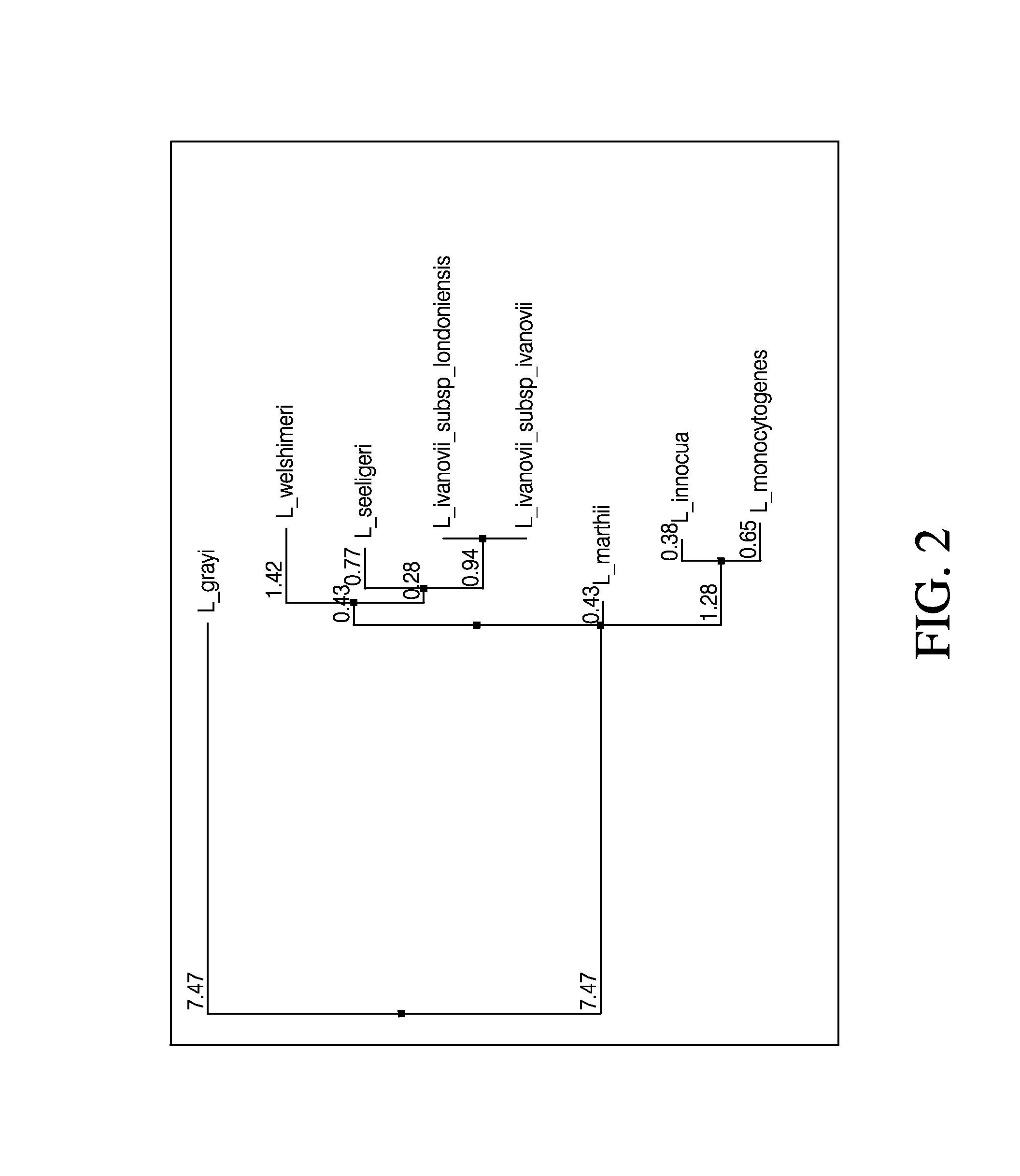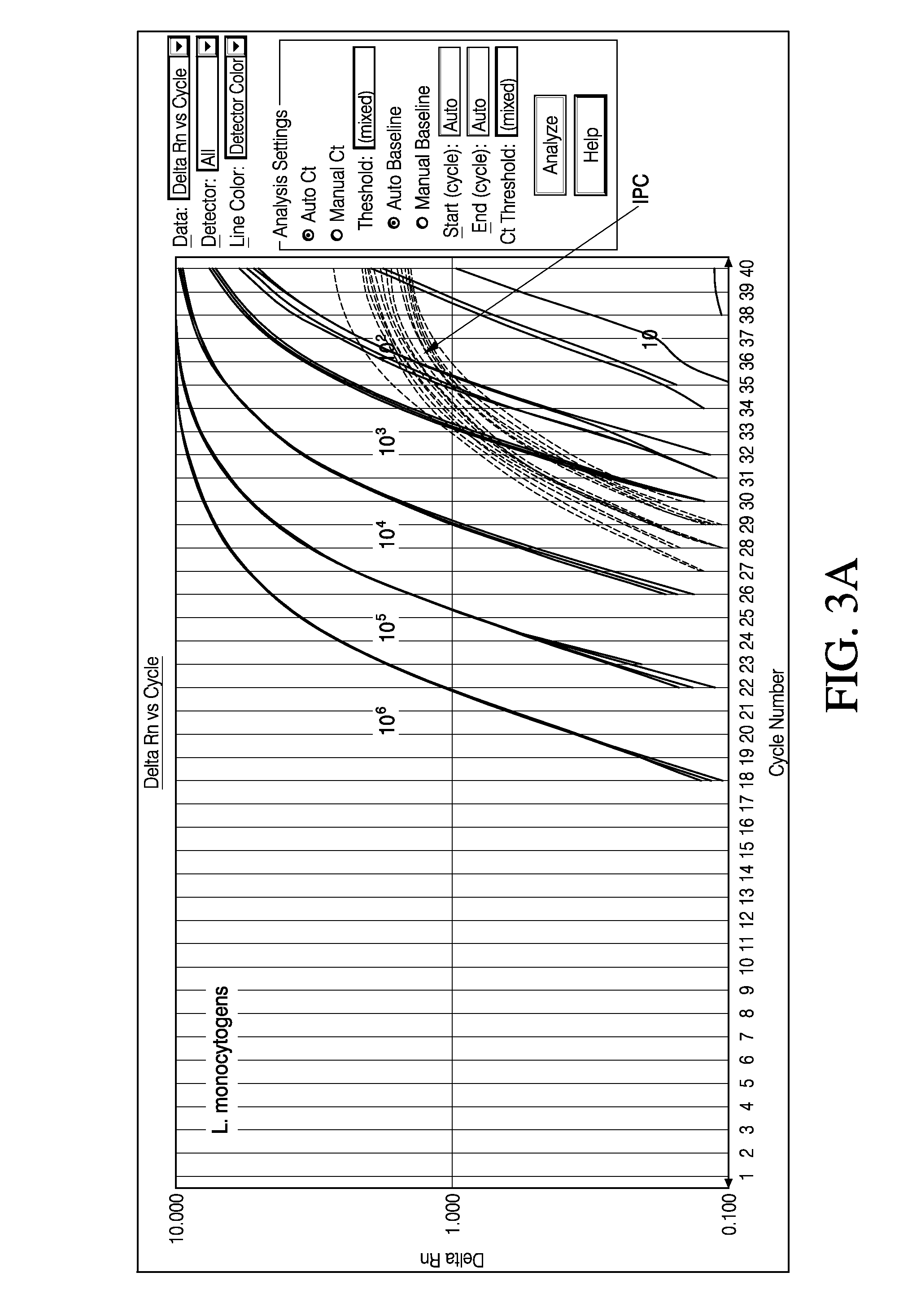Detection of Listeria species in food and environmental samples, methods and compositions thereof
a technology for listeria and food and environmental samples, applied in the field of compositions, methods and kits for detection and identification of listeria spp, can solve the problems of long traditional culture confirmation methods used in food and environmental safety testing, and the large reduction of the time-to-resul
- Summary
- Abstract
- Description
- Claims
- Application Information
AI Technical Summary
Benefits of technology
Problems solved by technology
Method used
Image
Examples
example 1
Primer / Probe Sets for Detection of Listeria spp other than L. grayi
[0133]Using bioinformatic comparisons, a portion of the sequence of the rnpB gene was found in common among various Listeria species, strains, cultivars, or serovars obtained from the following publicly available data repositories:
>gi|116245144_c3865-3748 Listeria monocytogenes FSL J2-064 NZ_AARO01000223;
>gi|113195789_c90201-90084 Listeria monocytogenes J0161 cont1.1;
>gi|154756709_c110353-110236 Listeria monocytogenes FSL J2-071; NZ_AARN02000030;
>gi|16799079_c2016439-2016322 Listeria innocua Clip11262;
>gi147096469_c1156-1039 Listeria monocytogenes str. 1 / 2a F6854 cont341;
>gi|116246567_c25083-24966 Listeria monocytogenes F6900 cont2.23;
>gi|83316099_c1943002-1942885 Listeria monocytogenes str. 4b F2365;
>gi|116740300_c1937597-1937480 Listeria welshimeri serovar 6b str. SLCC5334;
>gi|116235920_c8524-8407 Listeria monocytogenes FSL J1-175 NZ_AARK01000249;
>gi|116871422_c1937597-1937480 Listeria welshimeri serovar 6b str. S...
example 2
Primer / Probe Sets for Detection of Listeria grayi
[0143]The rnpB gene from four Listeria grayi strains (ATCC25402, ATCC25403, ATCC700545, and ATCC25401) obtained from the ATCC were sequenced (ATCC, American Type Culture Collection, Manassas, Va.). Using bioinformatic comparisons, a specific region of the rnpB gene was identified that can be used in specifically detecting the Listeria grayi species. Various PCR amplification primers and TaqMan® assays were designed against specific target areas of the rnpB gene specific to L. grayi and tested for specificity. In one embodiment, a forward primer has the sequence 5′-CCAAACTCTGACGGCAGGTAA-3′ (SEQ ID NO:5), a reverse primer has the sequence 5′-ACTTCGTCACTGTGGCACTTT-3′ (SEQ ID NO:6), and a probe has the sequence 5′-CAAGGCTACTACATCATATCT-3′ (SEQ ID NO:7) (see FIG. 1, Assay 24729).
[0144]This primer and probe set has been shown to be highly specific for Listeria grayi and provides highly specific assay results for the rapid detection of the ...
example 3
Listeria spp Duplexed Assays
[0148]The primers and probes of SEQ ID NO's:2-7 were combined to provide a duplexed form of the assays of Example 1 and Example 2 for detection of Listeria species, i.e.: L. monocytogenes, L. innocua, L. welshimeri, L. seeligeri, L. marthii (formerly incertae-sedis), L. ivanovii, and L. grayi.
[0149]Table 4 provides a summary of the TaqMan® assay data using the duplexed assay with primer / probe sets as set forth by SEQ ID NO's 2-7 on extracted gDNA (genomic DNA) from each of the listed Listeria species.
[0150]
TABLE 4Sample NameCTPE63 L. monocytogenes26.5345PE64 L. monocytogenes26.7799PE65 L. monocytogenes26.377PE66 L. monocytogenes27.6483PE67 L. monocytogenes25.6262PE68 L. monocytogenes26.1212PE69 L. monocytogenes27.1485PE77 L. monocytogenes25.1728PE78 L. monocytogenes34.4488PE79 L. monocytogenes26.6156PE80 L. monocytogenes25.7919PE81 L. monocytogenes26.7591PE82 L. monocytogenes28.2007PE83 L. monocytogenes24.9056PE84 L. monocytogenes26.2916PE85 L. monocytog...
PUM
| Property | Measurement | Unit |
|---|---|---|
| PCR efficiency | aaaaa | aaaaa |
| time | aaaaa | aaaaa |
| volumes | aaaaa | aaaaa |
Abstract
Description
Claims
Application Information
 Login to View More
Login to View More - R&D
- Intellectual Property
- Life Sciences
- Materials
- Tech Scout
- Unparalleled Data Quality
- Higher Quality Content
- 60% Fewer Hallucinations
Browse by: Latest US Patents, China's latest patents, Technical Efficacy Thesaurus, Application Domain, Technology Topic, Popular Technical Reports.
© 2025 PatSnap. All rights reserved.Legal|Privacy policy|Modern Slavery Act Transparency Statement|Sitemap|About US| Contact US: help@patsnap.com



